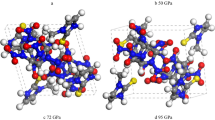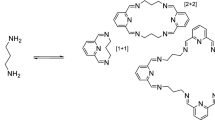Abstract
The crystal structures of the inclusion compounds of α-naphthaleneacetic acid molecule (NAA) in heptakis(2,6-di-O-methyl)-β-Cyclodextrin (DM-β-CD) and heptakis(2,3,6-tri-O-methyl)-β-Cyclodextrin (TM-β-CD) are reported. The NAA/DM-β-CD inclusion complex crystallizes in the P212121 space group and its asymmetric unit contains two host molecules arranged co-axially in a head-to-tail mode, each one encapsulating one NAA guest molecule disordered over two distinct sites. One more NAA molecule is found outside the DM-β-CDs cavities, clathrated in the interstice between four neighboring hosts. The anhydrous complex units form screw channels deployed along the crystallographic a-axis. The NAA/TM-β-CD inclusion complex also crystallizes in the space group P212121. The guest molecule, disordered over two sites, is accommodated with its naphthyl group laying in the secondary rim of the host. The complexes stack along the a-axis forming columns and the crystal packing consists of antiparallel columns related by the b screw axis. The binding mode of the guest and the conformation of the host in these two inclusion complexes, is affected significantly by the guest molecular shape, the rigidity of the host macrocycle and the host–guest interactions reflecting the importance of the induced-fit process for inclusion complexation with methylated cyclodextrins. Furthermore, molecular dynamics simulations in explicit aqueous solvent show that in the absence of the crystal contacts the favored inclusion mode of NAA in both DM-β-CD and TM-β-CD host is the one with its naphthyl group laying equatorially in the host cavity and its carboxymethyl group pointing towards the primary host rim tethered by hydrogen bonds with methoxy or glucosidic oxygen atoms of the host.





Similar content being viewed by others
Abbreviations
- NAA:
-
a-Naphthaleneacetic acid
- DM-β-CD:
-
Heptakis(2,6-di-O-methyl)-β-CD
- TM-β-CD:
-
Heptakis(2,3,6-tri-O-methyl)-β-CD
- DINA:
-
α-Naphthaleneacetic acid/heptakis(2,6-di-O-methyl)-β-Cyclodextrin inclusion compound
- TRINA:
-
α-Naphthaleneacetic acid/heptakis(2,3,6-tri-O-methyl)-β-Cyclodextrin inclusion compound
- MD:
-
Molecular dynamics
References
Van Uden, W., Woerdenbag, H.J., Pras, N.: Cyclodextrins as a useful tool for bioconversions in plant cell biotechnology. Plant Cell Tissue Organ Cult. 38(2), 103–113 (1994)
Mascuso, S., Rinaldelli, E., Mura, P., Faucci, M.T., Manderiolli, A.: Employment of indolebutyric and indoleacetic acids complexed by α-cydodextrin on cuttings rooting in Olea europaea L. cv. Leccio del Corno. Effects of concentration and treatment time. Adv. Hortic. Sci. 11(3), 153–157 (1997)
Miller, J.M., Yahiaoui, A.: Controlled release and plant-growth regulators. In: Gebelein, C.G., Carraher, C.E. (eds.) Bioactive Polymeric Systems, pp. 121–141. Springer, Boston (1985)
Martin, A.I., Sánchez-Chaves, M., Arranz, F.: Synthesis, characterization and controlled release behavior of adducts from chloroacetylated cellulose and α-naphthylacetic acid. React. Funct. Polym. 39(2), 179–187 (1999)
Han, H., Zhang, S., Sun, X.: A review on the molecular mechanism of plants rooting modulated by auxin. Afr. J. Biotechnol. 8(3), 348–353 (2009)
Yan, Y.-H., Li, J.-L., Zhang, X.-Q., Yang, W.-Y., Wan, Y., Ma, Y.-M., Zhu, Y.-Q., Peng, Y., Huang, L.-K.: Effect of naphthalene acetic acid on adventitious root development and associated physiological changes in stem cutting of Hemarthria compressa. PLoS ONE 9(3), e90700 (2014)
Paek, K., Yeung, E.: The effects of 1-naphthaleneacetic acid and N6-benzyladenine on the growth of Cymbidium forrestii rhizomes in vitro. Plant Cell Tissue Organ Cult. 24(2), 65–71 (1991)
Kashyap, V., Vinod Kumar, S., Colonnier, C., Fusari, F., Haicour, H., Rotino, G.L., Sihachakr, D., Rajam, M.V.: Biotechnology of eggplant. Sci. Hortic. 97(1), 1–25 (2003)
Mencuccini, M.: Effect of medium darkening on in vitro rooting capability and rooting seasonality of olive (Olea europaea L.) cultivars. Sci. Hortic. 97(2), 129–139 (2003)
Ramirez-Malagon, R., Borodanenko, A., Barrere-Guerra, J.L., Ochoa-Alejo, N.: Shoot number and shoot size as affected by growth regulators in in vitro cultures of Spathiphyllum floribundum L. Sci. Hortic. 89(3), 227–236 (2001)
Al-Bahrany, A.M.: Effect of phytohormones on in vitro shoot multiplication and rooting of lime Citrus aurantifolia (Christm.) Swing. Sci. Hortic. 95(4), 285–295 (2002)
Brutti, C., Apostolo, N.M., Ferrarotti, S.A., Llorente, B.E., Krymkiewicz, N.: Micropropagation of Cynara scolymus L. employing cyclodextrins to promote rhizogenesis. Sci. Hortic. 83(1), 1–10 (2000)
Dai, J., Kim, J.C.: Monoolein cubic phase containing ionizable aromatic compounds-loaded β-cyclodextrin polymers: FITC-dextran release property. Adv. Sci. Lett. 5, 247–252 (2012)
Lee, M.S., Kim, J.C.: Microgels formed by electrostatic and hydrophobic interaction of naphthaleneacetic acid with β-cyclodextrin-grafted polyethyleneimine. Colloid Polym. Sci. 289, 1177–1183 (2011)
Yang, X., Kim, J.-C.: Beta-cyclodextrin hydrogels containing naphthaleneacetic acid for pH-sensitive release. Biotechnol. Bioeng. 106(2), 295–302 (2010)
Cavallaro, V., Trotta, F., Gennari, M., Di Silvestro, I., Pellegrino, A., Barbera, A.C.: Effects of the complex nanosponges-naphthaleneacetic acid and β cyclodextrins on in vitro rhizogenesis of globe artichoke. Acta Hortic. 983, 369–372 (2013). https://doi.org/10.17660/ActaHortic.2013.983.52
Peña, A.M., Salanas, F., Gómez, M., Acedo, M., Peña, M.S.: Absorptiometric and spectrofluorimetric study of the inclusion complexes of 2-naphthyloxyacetic acid and 1-naphthylacetic acid with β-cyclodextrin in aqueous solution. J. Incl. Phenom. Macrocycl. Chem. 15(2), 131–143 (1993)
Wang, E.-J., Chen, G.-Y., Han, C.-R.: Crystal structure of a novel sandwich inclusion complex of β-cyclodextrin with a-naphthylacetic acid. Chem. Res. Chin. Univ. 27(5), 730–733 (2011)
Kokkinou, A., Yannakopoulou, K., Mavridis, I.M., Mentzafo, D.: Structure of the complex of beta-cyclodextrin with beta-naphthyloxyacetic acid in the solid state and in aqueous solution. Carbohydr. Res. 332(1), 85–94 (2001)
Triantafyllopoulou, V., Tsorteki, F., Mentzafos, D., Bethanis, K.: Inclusion compounds of plant growth regulators in cyclodextrins, part VII: study of the crystal structures of 2-naphthylacetic acid encapsulated in β-cyclodextrin and heptakis(2,3,6-tri-O-methyl)-β-cyclodextrin complexes by X-ray crystallography. J. Incl. Phenom. Macrocycl. Chem. 75(3), 303–310 (2013)
Uekama, K., Irie, T.: Pharmaceutical applications of methylated cyclodextrin derivatives. In: Duchene, D. (eds.) Cyclodextrins and Their Industrial Uses, pp. 395–439. Editions de Sante Paris (1987)
APEX 3, SAINT, SADABS Version 2012/1, 1, Bruker-AXS, Madison, Wisconsin, USA, 2012 (2012)
Sheldrick, G.M.: SADABS. (2012)
Sheldrick, G.M.: Experimental phasing with SHELXC/D/E: combining chain tracing with density modification. Acta Crystallogr. D 66, 479–485 (2010)
Sheldrick, G.M.: Crystal structure refinement with SHELXL. Acta Crystallogr. C 71, 3–8 (2015)
Hübschle, C.B., Sheldrick, G.M., Dittrich, B.: ShelXle: a Qt graphical user interface for SHELXL. J. Appl. Crystallogr. 44, 1281–1284 (2011)
Schüttelkopf, A.W., van Aalten, D.M.F.: PRODRG: a tool for high-throughput crystallography of protein–ligand complexes. Acta Crystallogr. D 60, 1355–1363 (2004)
Thorn, A., Dittrich, B., Sheldrick, G.M.: Enhanced rigid-bond restraints. Acta Crystallogr. A 68, 448–451 (2012)
Macrae, C.F., Bruno, I.J., Chisholm, J.A., Edgington, P.R., McCabe, P., Pidcock, E., Rodriguez-Monge, L., Taylor, R., van de Streek, J., Wood, P.A.: Mercury CSD 2.0 – new features for the visualization and investigation of crystal structures. J. Appl. Crystallogr. 41(2), 466–470 (2008)
Schrödinger, L.L.C.: The PyMOL Molecular Graphics System, Version 1.8 (2015)
Dolomanov, O.V., Bourhis, L.J., Gildea, R.J., Howard, J.A.K., Puschmann, H.: OLEX2: a complete structure solution, refinement and analysis program. J. Appl. Crystallogr. 42(2), 339–341 (2009)
Pedretti, A., Villa, L., Vistoli, G.: VEGA: a versatile program to convert, handle and visualize molecular structure on Windows-based PCs. J. Mol. Model. 21(1), 47–49 (2002)
Case, D.A., Cheatham, T., Darden, T., Gohlke, H., Luo, R., Merz, K.M. Jr., Onufriev, A., Simmerling, C., Wang, B., Woods, R.: The Amber biomolecular simulation programs. J. Comput. Chem. 26(16), 1668–1688 (2005)
Cezard, C., Trivelli, X., Aubry, F., Djedaini-Pilard, F., Dupradeau, F.-Y.: Molecular dynamics studies of native and substituted cyclodextrins in different media: 1. Charge derivation and force field performances. Phys. Chem. Chem. Phys. 13(33), 15103–15121 (2011)
Wang, J., Wang, W., Kollman, P.A., Case, D.A.: Automatic atom type and bond type perception in molecular mechanical calculations. J. Mol. Model. 25(2), 247–260 (2006)
Roe, D.R., Cheatham, T.E.: PTRAJ and CPPTRAJ: software for processing and analysis of molecular dynamics trajectory data. J. Chem. Theory Comput. 9(7), 3084–3095 (2013)
Humphrey, W., Dalke, A., Schulten, K.: VMD: visual molecular dynamics. J. Mol. Graph. 14(1), 33–38 (1996)
Wang, J., Morin, P., Wang, W., Kollman, P.A.: Use of MM-PBSA in reproducing the binding free energies to HIV-1 RT of TIBO derivatives and predicting the binding mode to HIV-1 RT of efavirenz by docking and MM-PBSA. J. Am. Chem. Soc. 123(22), 5221–5230 (2001)
Miller, B.R. III, McGee, T.D. Jr., Swails, J.M., Homeyer, N., Gohlke, H., Roitberg, A.E.J.: MMPBSA.py: an efficient program for end-state free energy calculations. J. Chem. Theory Comput. 8(9), 3314–3321 (2012)
Genheden, S., Ryde, U.: The MM/PBSA and MM/GBSA methods to estimate ligand-binding affinities. Expert Opin. Drug Discov. 10(5), 449–461 (2015)
Trollope, L., Cruickshank, D.L., Noonan, T., Bourne, S.A., Sorrenti, M., Catenacci, L., Caira, M.R.: Inclusion of trans-resveratrol in methylated cyclodextrins: synthesis and solid-state structures. Beilstein J. Org. Chem. 10, 3136–3151 (2014)
Takahashi, H., Tsuboyama, S., Umezawa, Y., Honda, K., Nishio, M.: CH/π interactions as demonstrated in the crystal structure of host/guest compounds. A database study. Tetrahedron 56, 6185–6191 (2000). https://doi.org/10.1016/S0040-4020(00)00575-5
Cremer, D., Pople, J.: General definition of ring puckering coordinates. J. Am. Chem. Soc. 97(6), 1354–1358 (1975)
Aree, T., Saenger, W., Leibnitz, P., Hoier, H.: Crystal structure of heptakis(2,6-di-O-methyl)-β-cyclodextrin dihydrate: a water molecule in an apolar cavity. Carbohydr. Res. 315, 199–205 (1999). https://doi.org/10.1016/S0008-6215(99)00033-6
Groom, C.R., Bruno, I.J., Lightfoot, M.P., Ward, S.C.: The Cambridge structural database. Acta Crystallogr. B 72, 171–179 (2016)
Cardinael, P., Peulon, V., Perez, G., Coquerel, G., Toupet, L.: Characterization of crystalline complexes between heptakis(2,3,6-tri-O-methyl)-β-cyclodextrin and various alkanes or alkenes (5 ≤ C ≤ 10)°. J. Incl. Phenom. Macrocycl. Chem. 39(1), 159–167 (2001)
Caira, M.R., Giordano, F., Vilakazi, S.L.: X-ray structure and thermal properties of a 1:1 inclusion complex between permethylated β-cyclodextrin and psoralen. Supramol. Chem. 16(6), 389–393 (2004). https://doi.org/10.1080/10610270410001713321
Caira, M.R., Griffith, V.J., Nassimbeni, L.R., Van Oudtshoorn, B.: X-ray structure and thermal analysis of a 1∶1 complex between (S)-naproxen and heptakis(2,3,6-tri-O-methyl)-β-cyclodextrin. J. Incl. Phenom. Mol. Recognit. Chem. 20, 277–290 (1994). https://doi.org/10.1007/BF00708773
Harata, K., Uedaira, H.: The circular dichroism spectra of the β-cyclodextrin complex with naphthalene derivatives. Bulletin Chem. Soc. Japan 48(2), 375–378 (1975). https://doi.org/10.1246/bcsj.48.375
Ueno, A., Takahashi, K., Osa, T.: One host-two guests complexation between γ-cyclodextrin and sodium α-naphthylacetate as shown by excimer fluorescence. J. Chem. Soc. Chem. Commun. (1980). https://doi.org/10.1039/C39800000921
Hamai, S.: Association of inclusion compounds of beta-cyclodextrin in aqueous solution. Bulletin Chem. Soc. Japan 55(9), 2721–2729 (1982)
Szejtli, J.: Cyclodextrin technology. Kluwer, Boston (1988)
Evans, C.H., Partyka, M., Van Stam, J.: Naphthalene complexation by β-cyclodextrin: influence of added short chain branched and linear alcohols. J. Incl. Phenom. Macrocycl. Chem. 38(1), 381–396 (2000). https://doi.org/10.1023/A:1008187916379
Harata, K.: The X-ray structure of an inclusion complex of heptakis(2,6-di-O-methyl)-beta-cyclodextrin with 2-naphthoic acid. J. Chem. Soc. Chem. Commun. (1993). https://doi.org/10.1039/C39930000546
Anibarro, M., Gessler, K., Uson, I., Sheldrick, G.M., Saenger, W.: X-ray structure of beta-cyclodextrin-2,7-dihydroxy-naphthalene.4.6H(2)O: an unusually distorted macrocycle. Carbohydr. Res. 333, 251–256 (2001)
Harata, K.: Crystallographic study of cyclodextrins and their inclusion complexes. In: Dodziuk, H. (eds.) Cyclodextrins and Their Complexes, pp. 147–198. Wiley, New York (2006)
Lindner, K., Saenger, W.: Crystal and molecular structure of cyclohepta-amylose dodecahydrate. Carbohydr. Res. 99, 103–115 (1982). https://doi.org/10.1016/S0008-6215(00)81901-1
Betzel, C., Saenger, W., Hingerty, B.E., Brown, G.M.: Topography of cyclodextrin inclusion complexes, part 20. Circular and flip-flop hydrogen bonding in beta-cyclodextrin undecahydrate: a neutron diffraction study. J. Am. Chem. Soc. 106, 7545–7557 (1984). https://doi.org/10.1021/ja00336a039
Li, J.-Y., Sun, D.-F., Hao, A.-Y., Sun, H.-Y., Shen, J.: Crystal structure of a new cyclomaltoheptaose hydrate: β-cyclodextrin·7.5H2O. Carbohydr. Res. 345, 685–688 (2010). https://doi.org/10.1016/j.carres.2009.12.016
Mentzafos, D., Mavridis, I.M., Le Bas, G., Tsoucaris, G.: Structure of the 4-tert-butylbenzyl alcohol–β-cyclodextrin complex. Common features in the geometry of β-cyclodextrin dimeric complexes. Acta Crystallogr. B 47, 746–757 (1991). https://doi.org/10.1107/S010876819100366X
Author information
Authors and Affiliations
Corresponding author
Electronic supplementary material
Below is the link to the electronic supplementary material.
Rights and permissions
About this article
Cite this article
Bethanis, K., Christoforides, E., Tsorteki, F. et al. Structural studies of the inclusion compounds of α-naphthaleneacetic acid in heptakis(2,6-di-O-methyl)-β-Cyclodextrin and heptakis(2,3,6-tri-O-methyl)-β-Cyclodextrin by X-ray crystallography and molecular dynamics. J Incl Phenom Macrocycl Chem 92, 157–171 (2018). https://doi.org/10.1007/s10847-018-0824-y
Received:
Accepted:
Published:
Issue Date:
DOI: https://doi.org/10.1007/s10847-018-0824-y




